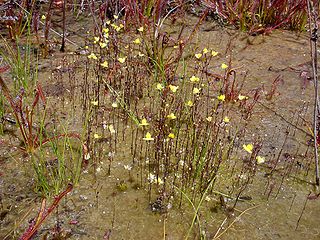
Utricularia subulata, the zigzag bladderwort, is a small annual, terrestrial carnivorous plant that belongs to the genus Utricularia. It is the most widely distributed species in the genus, being almost pantropical.
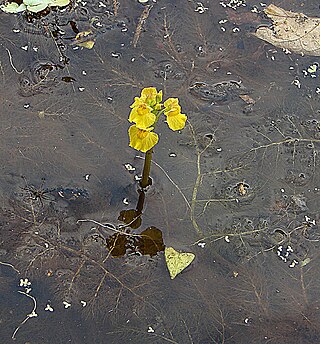
Utricularia foliosa, the leafy bladderwort, is a large suspended aquatic carnivorous plant that belongs to the genus Utricularia. It is probably a perennial plant that cultivates in lake, swamps and ponds. U. foliosa is native to Africa and North and South America, widely distributed among many countries. Although, they are widely distributed around the world, very little studies have been contributed to U. foliosa. They like to sprout all year long, and found in large body of water. The environment that Utricularia foliosa are found in are experiencing negative anthropogenic impacts such as drainage and conversion to urban or agricultural activities are causing rapid environmental degradation.

Utricularia inflexa is a medium to large sized suspended aquatic carnivorous plant that belongs to the genus Utricularia. It is probably a perennial plant. U. inflexa is endemic to Africa and the Indian subcontinent.
Utricularia reflexa is a small to medium-sized suspended aquatic carnivorous plant that belongs to the genus Utricularia. U. reflexa is native to Africa and can be found in Benin, Burkina Faso, Burundi, Cameroon, Chad, the Central African Republic, Côte d'Ivoire, the Democratic Republic of the Congo, Gambia, Ghana, Guinea, Kenya, Madagascar, Malawi, Mali, Niger, Nigeria, Senegal, Sierra Leone, Sudan, Tanzania, Togo, Uganda, Zambia, and Zimbabwe.
Utricularia appendiculata is a medium-sized, probably perennial, terrestrial carnivorous plant that belongs to the genus Utricularia and is the only member of Utricularia sect. Oliveria. U. appendiculata is endemic to Africa, where it can be found in Burundi, Cameroon, the Central African Republic, the Democratic Republic of the Congo, Gabon, Madagascar, Malawi, Mozambique, Tanzania, Uganda, and Zimbabwe. It grows as a terrestrial plant in wet Sphagnum bogs, damp sandy savannas, or in peaty marshes at altitudes from 1,500 m (4,921 ft) to 1,860 m (6,102 ft), but as low as 700 m (2,297 ft) in the Central African Republic. It flowers mostly in the wet season. It was originally published and described by Eileen Adelaide Bruce in 1933 and was placed in its own section, Oliveria, in 1986 by Peter Taylor.
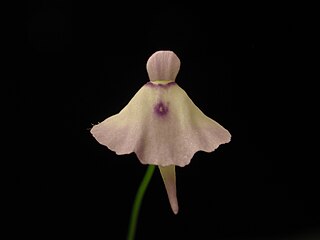
Utricularia pubescens is a small to medium-sized, probably annual, terrestrial or lithophytic carnivorous plant that belongs to the genus Utricularia and is the only member of Utricularia sect. Lloydia. U. pubescens is native to India, tropical Africa, and Central and South America. It was originally published and described by James Edward Smith in 1819 and placed in its own section, Lloydia, by Peter Taylor in 1986. It grows as a terrestrial or lithophytic plant in boggy grasslands in damp peaty soils at altitudes from sea level to 1,900 m (6,234 ft). This species possesses small peltate leaves, which are diagnostic for this species in the genus.
Utricularia rigida is a small to medium-sized perennial, rheophytic carnivorous plant that belongs to the genus Utricularia. U. rigida is endemic to western tropical Africa, where it can be found in Côte d'Ivoire, Guinea, Guinea-Bissau, Mali, Nigeria, Senegal, and Sierra Leone. It grows as a rheophyte on inclined rock faces in swiftly running water at altitudes from near sea level to 1,250 m (4,101 ft). It was originally described and published by Ludwig Benjamin in 1847. It is distinguished from the other species in the section, U. tetraloba, by having only two lower lip corolla lobes as opposed to U. tetraloba's four.

Utricularia juncea, the southern bladderwort, is a small to medium-sized, probably perennial carnivorous plant that belongs to the genus Utricularia. U. juncea is native to Central, South, and North America. It grows as a terrestrial plant in marshes, swamps, and pools in shallow waters, mostly at lower altitudes. It was originally described and published by Martin Vahl in 1804.
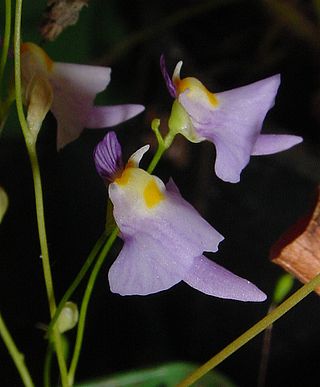
Utricularia sect. Nigrescentes is a section in the genus Utricularia. The three species in this section are small terrestrial carnivorous plants native to tropical Africa, Asia, and Australia. Daniel Oliver originally validly described and published this section in 1859, but did not specify the rank used by the group. Sadashi Komiya revised the section in 1973. Peter Taylor, in his 1989 taxonomic monograph on the genus, placed this section within subgenus Utricularia. More recent phylogenetic data and revisions have reinstated subgenus Bivalvaria and have placed this section within it.
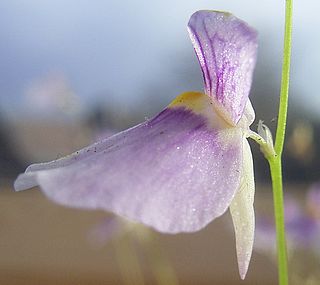
Utricularia sect. Aranella is a section in the genus Utricularia. The ten species in this section are small terrestrial carnivorous plants native to tropical South America with one species also extending into tropical Africa. John Hendley Barnhart originally described and published this section in 1913 as a separate genus, Aranella. Sadashi Komiya revised the genus Utricularia in a 1973 taxonomic review and placed Barnhart's genus at the rank of subgenus within Utricularia. Peter Taylor then published his taxonomic monograph of Utricularia in 1986 in which he reduced Komiya's subgenus to the rank of section, placing it within subgenus Utricularia. More recent phylogenetic data and revisions have reinstated subgenus Bivalvaria and have placed this section within it.
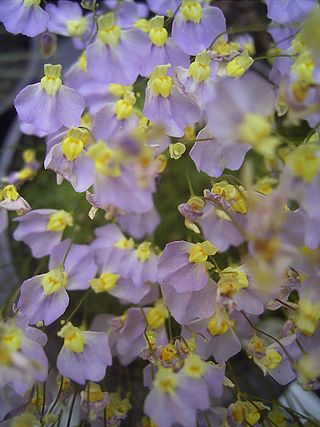
Utricularia sect. Calpidisca is a section in the genus Utricularia. The ten species in this section are small terrestrial carnivorous plants native to Africa with one species extending its range into Mexico and another that extends into Asia as far as India. John Hendley Barnhart originally described and published this section in 1916 as a separate genus, Calpidisca. Sadashi Komiya revised the genus Utricularia in a 1973 taxonomic review and placed Barnhart's genus at the rank of section within Utricularia. Peter Taylor then published his taxonomic monograph of Utricularia in 1986 in which he placed Komiya's section within subgenus Utricularia. More recent phylogenetic data and revisions have reinstated subgenus Bivalvaria and have placed this section within it.
Utricularia welwitschii is a small to medium-sized, probably perennial, carnivorous plant that belongs to the genus Utricularia. It is endemic to tropical Africa, where it can be found in the Democratic Republic of the Congo, Madagascar, Malawi, South Africa, Tanzania, Zambia, and Zimbabwe. U. welwitschii grows as a terrestrial plant in sandy or peaty soils in marshy grasslands at altitudes from 1,000 m (3,281 ft) to 2,200 m (7,218 ft). It was originally described and published by Daniel Oliver in 1865. Taylor previously described two varieties of U. welwitschii, U. welwitschii var. odontosepala and U. welwitschii var. microcalyx, in 1964, but later elevated them to the rank of species as U. odontosepala and U. microcalyx, respectively. It is named in honor of Friedrich Welwitsch.

Utricularia sect. Oligocista is the largest section in the genus Utricularia. The 42 species in this section are small to medium-sized terrestrial carnivorous plants native throughout the tropics, with six species in the Americas, ten in Africa, five in Australia, and the remainder in Asia, with 17 mostly native to peninsular India. Alphonse Pyrame de Candolle originally described and published this section in 1844. Peter Taylor published his taxonomic monograph of Utricularia in 1986, in which he placed this section within subgenus Utricularia. More recent phylogenetic data and revisions have reinstated subgenus Bivalvaria and have placed this section within it.
Utricularia foveolata is a small, probably annual, carnivorous plant that belongs to the genus Utricularia. It is native to the Old World tropics, where it can be found in Africa, Asia, Australia, and on the eastern end of Java. U. foveolata grows as a terrestrial or subaquatic plant in wet soils or in shallow water, sometimes as a weed in rice fields in Asia. It was originally described and published by Michael Pakenham Edgeworth in 1847.
Utricularia spiralis is a medium to large-sized, probably perennial carnivorous plant that belongs to the genus Utricularia. It is endemic to tropical Africa and can be found in Angola, Burundi, Chad, Côte d'Ivoire, the Democratic Republic of the Congo, Gabon, Guinea, Liberia, Malawi, Sierra Leone, Tanzania, and Zambia. U. spiralis grows as a terrestrial plant in swamps or marshes in peaty or sandy soils at altitudes from sea level to 1,860 m (6,102 ft). It was originally described by James Edward Smith in 1819.

Utricularia striatula is a small carnivorous plant that belongs to the genus Utricularia. It is widespread from tropical Africa to New Guinea. U. striatula grows as a lithophyte or epiphyte on wet rocks or tree trunks at altitudes from near sea level to 3,300 m (10,827 ft). It was originally described by James Edward Smith in 1819.

Utricularia sect. Setiscapella is a section in the genus Utricularia that contains small or medium-sized terrestrial or subaquatic species. Most plants in this section are endemic to Central and South America with the exceptions of Utricularia stanfieldii, which is endemic to Africa, and Utricularia subulata which is almost pantropical. It was first described by John Hendley Barnhart in 1916 at the rank of genus. In 1973, Sadashi Komiya reduced the genus to a subgenus of the genus Utricularia. In his 1986 monograph on the genus, Peter Taylor reorganized the genus and reduced this to the rank of section.

Australia has one of the world's richest carnivorous plant floras, with around 187 recognised species from 6 genera.















